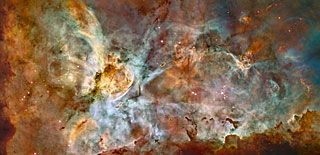To celebrate HST 17th anniversary, STScI released this
astonishing image of the eta Carinae Nebula, the largest image ever taken
with HST.You can click in the image to zoom in and see the details of
star formation in the Carina nebula.
Visible
light
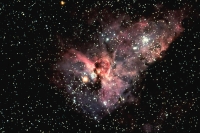 This optical image (0.35-0.75 microns) displays the nebula and stellar
clusters in the eta Car neighborhood, in an extension of tens of ligh-years.Those
blue (hot) and luminous stars ionize the interstellar gas clouds, producing
an HII Nebulae much larger than Orion. It can be spotted at naked eye
(far from city lights) as a white nebulosity, to the right of the Southern
Cross in the first semester of the year. Only observers located south
of latitute +30 degrees are able to see et Car. Image
from CTIO/NOAO
This optical image (0.35-0.75 microns) displays the nebula and stellar
clusters in the eta Car neighborhood, in an extension of tens of ligh-years.Those
blue (hot) and luminous stars ionize the interstellar gas clouds, producing
an HII Nebulae much larger than Orion. It can be spotted at naked eye
(far from city lights) as a white nebulosity, to the right of the Southern
Cross in the first semester of the year. Only observers located south
of latitute +30 degrees are able to see et Car. Image
from CTIO/NOAO
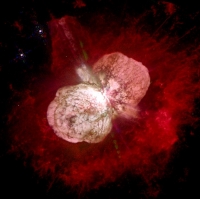 This is one of the highest resolution images taken in night time (0.05 arcsec).
The bright spot at the center contains the star, that is hidden at optical
wavelengths. The peanut shaped nebula composed of gas and dust is called
Homunculus (little man), that was ejected in the 1843 grest eruption and
is expanding at speed of ~600 Km/s. The red nebula around the Homunculus
is made by gases ejected in a previous event - perhaps 1000 years ago. The
dust contents in the Homunculus is enough to make a thousand planets like
those of the solar system together. The size of the Homunculus looks
small (17 arcsec) due to the fact that it lies 8 thousands light-years away
(72 million billion Km). As a matter of fact, it is huge: 500 times
the size of the solar system, that in this picture is only of the size of
one of the smallest dark dots. A chemical analisis reveals that the gas
was processed by nuclear reactions inside the star, indicating that it life
is ending. The central source displays only a little fading in the optical
wavelengths, during the 5.53 year cycle.
Hubble Space Telescope, see a movie of the expansion =>
Jon Morse
This is one of the highest resolution images taken in night time (0.05 arcsec).
The bright spot at the center contains the star, that is hidden at optical
wavelengths. The peanut shaped nebula composed of gas and dust is called
Homunculus (little man), that was ejected in the 1843 grest eruption and
is expanding at speed of ~600 Km/s. The red nebula around the Homunculus
is made by gases ejected in a previous event - perhaps 1000 years ago. The
dust contents in the Homunculus is enough to make a thousand planets like
those of the solar system together. The size of the Homunculus looks
small (17 arcsec) due to the fact that it lies 8 thousands light-years away
(72 million billion Km). As a matter of fact, it is huge: 500 times
the size of the solar system, that in this picture is only of the size of
one of the smallest dark dots. A chemical analisis reveals that the gas
was processed by nuclear reactions inside the star, indicating that it life
is ending. The central source displays only a little fading in the optical
wavelengths, during the 5.53 year cycle.
Hubble Space Telescope, see a movie of the expansion =>
Jon MorseX-Rays
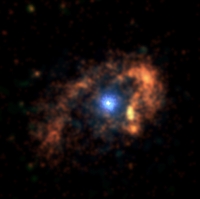 This image in X-rays was collected by the orbital X-ray satesta imagem
foi tomada pelo satélite Chandra satelite in the spectral range
1-10 Kev ( ~1/1000 of the optical wavelength). The central source (white
dot) is 63 million K hot and is coincident with the position of the optical
source. It appears to be formed by the wind-wind collision (see MODEL
bellow). The bluish halo seems to be due to X-rays scattered by dust.
The orange horseshoe shaped nebula is 3 million K hot and is due
to the collision of the gases ejected ~1 thousnad years ago, against the
interstellar medium . The image to the right shows the size of the Homunculus
(optical) compared to the X-ray image. The central X-ray source fades
completely during the blackouts the occur every 5.53 years.
Chandra images, see also a X-ray movie by Mike
Corcoran
This image in X-rays was collected by the orbital X-ray satesta imagem
foi tomada pelo satélite Chandra satelite in the spectral range
1-10 Kev ( ~1/1000 of the optical wavelength). The central source (white
dot) is 63 million K hot and is coincident with the position of the optical
source. It appears to be formed by the wind-wind collision (see MODEL
bellow). The bluish halo seems to be due to X-rays scattered by dust.
The orange horseshoe shaped nebula is 3 million K hot and is due
to the collision of the gases ejected ~1 thousnad years ago, against the
interstellar medium . The image to the right shows the size of the Homunculus
(optical) compared to the X-ray image. The central X-ray source fades
completely during the blackouts the occur every 5.53 years.
Chandra images, see also a X-ray movie by Mike
Corcoran
MODEL
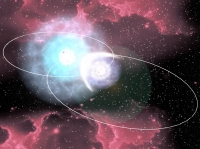 Computer image of the binary system model. The binary stars are in the
center of the Homunculus. The period is 5.53 years, the orbits are very
eccentric with a size similar to Jupiter orbit. Both stars have strong
winds. The more massive (to the left) is the coldest one (~15000K) and
the smaller one is hottest (~30000K). The winds suffer a tremendous collision
heating the gas up to 63 million K (white arc inbetween the two stars).
When the smaller star (smaller) approaches the periastron, it plunges
inside the dense wind of the primary star, producing a blanketting of
the UV ionizing photons. This is the mechanism under the periodic "blackouts"
that occur cyclicly every 5.53 years. In X-rays the emission is enhanced
near periastron, but the huge absortpion produced by the column density
of gas obscures the wind-wind colliding zone, producing an eclipse simultaneous
with the ionization "blackout". (clik
here to see a large update version)
Computer image of the binary system model. The binary stars are in the
center of the Homunculus. The period is 5.53 years, the orbits are very
eccentric with a size similar to Jupiter orbit. Both stars have strong
winds. The more massive (to the left) is the coldest one (~15000K) and
the smaller one is hottest (~30000K). The winds suffer a tremendous collision
heating the gas up to 63 million K (white arc inbetween the two stars).
When the smaller star (smaller) approaches the periastron, it plunges
inside the dense wind of the primary star, producing a blanketting of
the UV ionizing photons. This is the mechanism under the periodic "blackouts"
that occur cyclicly every 5.53 years. In X-rays the emission is enhanced
near periastron, but the huge absortpion produced by the column density
of gas obscures the wind-wind colliding zone, producing an eclipse simultaneous
with the ionization "blackout". (clik
here to see a large update version)
Infrared
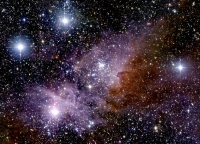 This image was taken with the 2MASS telescope at CTIO (Chile), in the
near-infrared (1.25-2.3 microns). It displays the region near eta Carinae,
the bright star at the low left corner. Compare this image with the optical
one at the top of this page and see that many more stars are seens in
the infrared than optical wavelengths. This is due to the fact that the
inerstellar dust absorbs much more the shorter wavelength light (optical,
UV and X-rays) than the longer ones (infrared and radio). The eta Car
light in this spectral range is due to very hot dust (1000K). Eta Car
shows a moderate light modulation along the 5.53-year cycles in the near-infrared.
2MASS
da Universidade de Massachusetts
This image was taken with the 2MASS telescope at CTIO (Chile), in the
near-infrared (1.25-2.3 microns). It displays the region near eta Carinae,
the bright star at the low left corner. Compare this image with the optical
one at the top of this page and see that many more stars are seens in
the infrared than optical wavelengths. This is due to the fact that the
inerstellar dust absorbs much more the shorter wavelength light (optical,
UV and X-rays) than the longer ones (infrared and radio). The eta Car
light in this spectral range is due to very hot dust (1000K). Eta Car
shows a moderate light modulation along the 5.53-year cycles in the near-infrared.
2MASS
da Universidade de Massachusetts
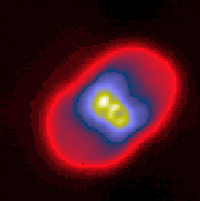 Mid-infrared image (18 microns) made with the Blanco telescope (CTIO). In
this wavelength, eta Carinae is the brigthest source all over the sky outside
of the solar system. Eta Car isn't seen at this wavelength, only the dust
is revealed. The dust in the central parts of the Homunculus (white zones)
is heated to about 0 degrees Celsius. The size of the dust grains is very
large (~2 microns) for the as compared to normal interstellar. No light
modulation along the 5.53 years cycle was detected in the mid-infrared.
University
of Florida
Mid-infrared image (18 microns) made with the Blanco telescope (CTIO). In
this wavelength, eta Carinae is the brigthest source all over the sky outside
of the solar system. Eta Car isn't seen at this wavelength, only the dust
is revealed. The dust in the central parts of the Homunculus (white zones)
is heated to about 0 degrees Celsius. The size of the dust grains is very
large (~2 microns) for the as compared to normal interstellar. No light
modulation along the 5.53 years cycle was detected in the mid-infrared.
University
of FloridaRadio
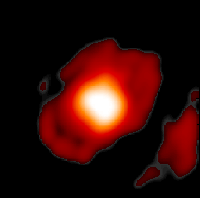 This image was made with the Australian radio Telescope at 6 cm wavelength.
The resolution of this image (~1 arcsec) is very high for the radioastronomy
standards. I reveals the stellar wind expelled by the star (white circle).
The red cloud is due to thermal emission from warm dust. The radio source
undergoes strong variability along the 5.53 years cycle. See
a movie of radio variability => S.
White - see also Bob
Duncan
This image was made with the Australian radio Telescope at 6 cm wavelength.
The resolution of this image (~1 arcsec) is very high for the radioastronomy
standards. I reveals the stellar wind expelled by the star (white circle).
The red cloud is due to thermal emission from warm dust. The radio source
undergoes strong variability along the 5.53 years cycle. See
a movie of radio variability => S.
White - see also Bob
Duncan
To download (slow connection) or execute (high speed connection)
Talk (mixed
Potuguese/English powerpoint: 10.7 MB)
Zoom (powerpoint
1.4 MB)
Videoclip (by
André Fonseca da Silva 860 KB zipped)
